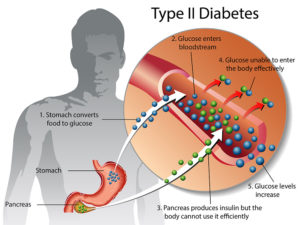 Type 2 diabetes is characterized by the body’s inability to adequately remove glucose (sugar) from the blood and get it into the cells where it can be used for energy. If left undetected and untreated, it can quickly lead to heart disease, stroke, kidney damage (leading to renal failure requiring a kidney transplant or dialysis), eye damage, and nerve damage (leading to non-healing wounds, infection, gangrene, and amputation). It can also lead to a serious condition known as diabetic ketoacidosis. This condition requires immediate lifesaving medical attention.
Type 2 diabetes is characterized by the body’s inability to adequately remove glucose (sugar) from the blood and get it into the cells where it can be used for energy. If left undetected and untreated, it can quickly lead to heart disease, stroke, kidney damage (leading to renal failure requiring a kidney transplant or dialysis), eye damage, and nerve damage (leading to non-healing wounds, infection, gangrene, and amputation). It can also lead to a serious condition known as diabetic ketoacidosis. This condition requires immediate lifesaving medical attention.
According to the Center for Disease Control’s 2020 National Diabetes Statistics Report, 34.2 million Americans have diabetes (10.5% of the US population), and an estimated 7.3 million of these are undiagnosed (21.4%). Because of the devastating effects and damage caused by this disease, early detection and treatment is vitally important.
Diabetes & Insulin
Insulin is a hormone produced by the pancreas that is responsible for transporting glucose out of the blood, and into the cells where it can be used for energy. In diabetes, either there is a problem with insulin production (this is known as type 1 diabetes and accounts for approximately 5-10% of cases) or, there is a problem with the insulin getting into the cells (known as insulin resistance). This is known as type 2 diabetes, and accounts for approximately 95% of cases. Excess glucose in the blood (hyperglycemia) will rapidly cause the medical problems and damage mentioned above.
Signs & Symptoms
- Increased thirst
- Frequent urination
- Blurred vision
- Unexplained weight loss
- Extreme hunger
- Fatigue
- Irritability
- Slow-healing sores or cuts.
- Itchy skin
- Frequent yeast infections.
- Numbness and tingling of the hands and feet.
- Decreased vision.
It is important to note that there are often no symptoms in the early stages of type 2 diabetes, but that damage is still occurring.
Risk Factors
- Overweight/obese (this is the greatest risk factor)
- 45 years of age or older
- Have a family member with type 2 diabetes
- Are physically active less than 3 times a week
- Have ever had gestational diabetes (diabetes during pregnancy)
- Are African American, Hispanic/Latino American, American Indian, or Alaska Native (diabetes can affect any race/ethnicity but the above group is particularly vulnerable).
If you are experiencing any of the above symptoms, or possess any of the above-mentioned risk factors, please have your screening done as soon as possible.
Your Screening & What to Expect
The good news is that type 2 diabetes can be detected using a simple finger stick blood test. The value we are concerned with is known as the hemoglobin A1C level. This result will provide information about your average blood glucose levels over the past 2-3 months. A1C test results are reported as a percentage. The higher the percentage, the higher your blood sugar levels over the past 2-3 months. An A1C level of 6.5% or higher indicates your levels were in the diabetic range and would likely result in a type 2 diabetes diagnosis. Your test results will be sent to you. Please be sure to share them with your primary care physician.
If your test result is indicative of diabetes you can expect your physician to recommend the following:
- Lifestyle changes (especially regarding diet and exercise)
- Expect to begin monitoring your blood glucose levels. This is done at home using a device known as a glucometer.
- You can also expect to be prescribed oral diabetes medications, or insulin, which must be injected, or both
- You will also receive teaching/instruction regarding diabetes and diabetes management. This step is extremely important in avoiding/minimizing the organ and tissue damage that occurs as a result of elevated blood glucose levels.
If you are experiencing any of the above symptoms, or possess any of the above-mentioned risk factors, please have your screening done as soon as possible.
